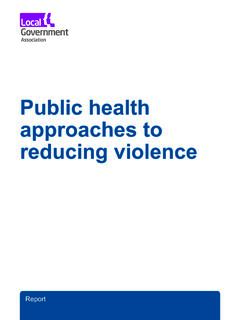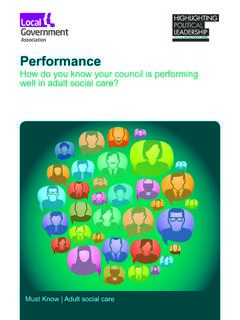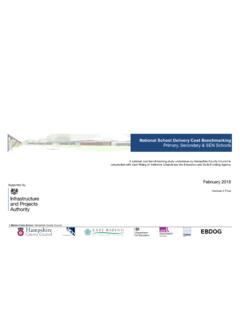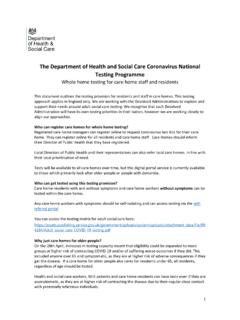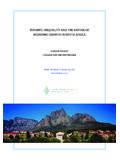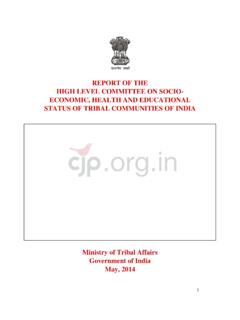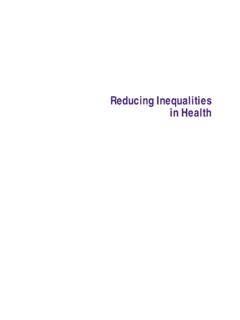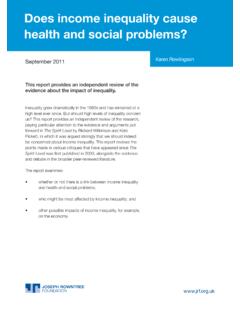Transcription of Health and wellbeing in rural areas
1 Health and wellbeing in rural areas Title studies Case Case studies This document has been produced by the LGA in partnership with PHE. Cover image Crown copyright and database right 2017. Image of Duncan Selbie Guzelian Contents Foreword 3. Executive summary 5. 1. Why is this important? 9. rural communities are very different 9. Pockets of deprivation can be masked by statistics 10. rural communities are increasingly older and are less diverse 12. Local government has many roles 13. District, town and parish councils are key players 13. 2. Health in rural communities 15. 3. What are the Health risks for rural populations?
2 17. Changing population patterns 18. Infrastructure 20. Digital access and exclusion 21. Air quality 23. Access to Health and related services 24. Lack of community support, isolation and social exclusion 31. Housing and fuel poverty 34. Employment and unemployment 37. 4. Questions to consider in developing strategies for rural Health 40. 5. Further information 41. Health and wellbeing in rural areas 3. Foreword Nearly 10 million of our fellow citizens live Council and in Imperial College, looking at in areas of England defined as rural . This measures that could more accurately capture number is increasing and the population is rural deprivation and ill Health .
3 Growing older. Their Health is as important to us as the Health of the 45 million who live in We know also that local authorities and our cities and large conurbations. Directors of Public Health (DsPH) have come up with innovative ways to identify and We don't know enough about the Health of reach out to groups and areas experiencing people living in remote farming areas , in the deprivation and ill Health that is not typical small market towns and in the coastal villages of a country or region as a whole. And in that make up much of what we think of as some parts of the country such areas and the countryside'.
4 These are very diverse groups can encompass significant numbers environments which cannot all be lumped within the population. Part of our purpose in together for analysis or understood together producing this publication is to encourage as a whole. Although many rural areas are, in local authorities to build on and share general, affluent, even wealthy in some cases, their work, not only in disaggregating their this is not true of all rural areas (the north/ populations, but also in designing Health and south divide' can be seen in the countryside care interventions that target those most in as well as in cities).
5 And within even the most need in rural communities. Such targeting affluent areas , there can be real hardship, is necessary because of the different ways deprivation, ill Health and inequalities. These the social determinants of Health impact on are some of the issues discussed in this rural populations. For example, services need document. to take account of difficulties of transport in remote areas . The resource-intensive nature One of our concerns is that, while of the work required for population-level poverty , deprivation and the ill Health that interventions to be redesigned effectively to accompanies them look much the same meet the specific needs, culture and lifestyles everywhere that they exist in England, they of different groups (including people living in can nonetheless be more difficult to identify remote or isolated locations, and/or working in the official statistics for rural areas than in farming, seasonal work and the fishing they are in urban areas .)
6 This is because the industry) makes it difficult for local authorities statistics are often not sufficiently fine grained and public Health teams to invest sufficiently to pinpoint the pockets of deprivation that in this work. exist among rural affluence. Indices recently and currently in use have tended to focus However, despite the financial constraints on the type of material disadvantage that is they are working under, local authorities most prevalent in an area, with the result that and their public Health teams are doing an area can be classified as not deprived' imaginative work that responds to the specific when in fact there is serious endemic poverty needs of people living in many different rural and deprivation within it.
7 We are pleased that settings. The case studies throughout the text there is work going on in the University of East below illustrate the variety of interventions Anglia in collaboration with Norfolk County taking place around the country. We are 4 Health and wellbeing in rural areas particularly pleased to read of examples that go far beyond the traditional medical model'. of public Health and build on some of local authorities' other responsibilities, for example in planning, housing, economic regeneration and leisure services, working with other parts of the public sector. A Health in All Policies'. (HiAP), place-based approach builds both on the strengths of public Health and on the reach and influence of local government's many other functions.
8 We hope that this publication is useful in sharing what is known about the Health of rural communities, where certain social determinants may have a greater impact in the countryside than they do in cities and how local authorities and their public Health teams are developing innovative partnerships to address the Health inequalities that we know exist within and between rural areas . Councillor Izzi Seccombe Duncan Selbie Chair, LGA Community wellbeing Board Chief Executive, Public Health England Health and wellbeing in rural areas 5. Executive summary Nineteen per cent of the population of rural communities are increasingly older.
9 England live in rural areas which make up 85 The younger population tends to decline the per cent of the land. These areas are very more rural the settlement type. Older people diverse, ranging from open countryside with experience worse Health and have greater a scattering of small towns and villages to need of Health and care services. Financial coastal communities dependent on fishing or poverty in rural areas is highly concentrated tourism, former mining areas and commuter amongst older people. Health and care villages. needs are difficult to separate for those with multiple and complex needs and reductions One local authority area can contain a number in resources for social care are compounded of different rural communities as well as by high delivery costs and organisational cities and towns and can exemplify Health challenges in sparse areas .
10 Inequalities with life expectancy differing across different groups by up to 10 years. Reductions in resources to care for the older Because of this diversity, local authorities population, issues of access to Health and need to understand in some detail the care services, travelling and transport issues character of their rural populations and the and lack of community support in some areas Health issues facing them. contribute to pressures on local government and the NHS to take a place-based approach Overall, Health outcomes are more favourable to Health needs. in rural areas than in urban areas . But broad- brush indicators can mask small pockets Many local authority functions have a Health of significant deprivation and poor Health impact.
